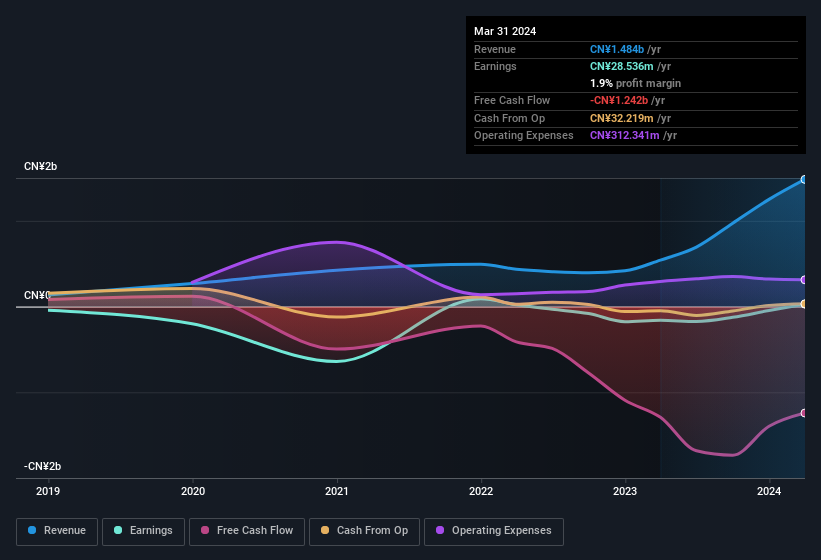- China
- /
- Semiconductors
- /
- SHSE:688234
We Think Shareholders Should Be Aware Of Some Factors Beyond SICC's (SHSE:688234) Profit
After announcing healthy earnings, SICC Co., Ltd.'s (SHSE:688234) stock rose over the last week. However, we think that shareholders should be aware of some other factors beyond the profit numbers.
See our latest analysis for SICC

A Closer Look At SICC's Earnings
As finance nerds would already know, the accrual ratio from cashflow is a key measure for assessing how well a company's free cash flow (FCF) matches its profit. To get the accrual ratio we first subtract FCF from profit for a period, and then divide that number by the average operating assets for the period. The ratio shows us how much a company's profit exceeds its FCF.
That means a negative accrual ratio is a good thing, because it shows that the company is bringing in more free cash flow than its profit would suggest. While it's not a problem to have a positive accrual ratio, indicating a certain level of non-cash profits, a high accrual ratio is arguably a bad thing, because it indicates paper profits are not matched by cash flow. To quote a 2014 paper by Lewellen and Resutek, "firms with higher accruals tend to be less profitable in the future".
For the year to March 2024, SICC had an accrual ratio of 0.35. We can therefore deduce that its free cash flow fell well short of covering its statutory profit, suggesting we might want to think twice before putting a lot of weight on the latter. Even though it reported a profit of CN¥28.5m, a look at free cash flow indicates it actually burnt through CN¥1.2b in the last year. We also note that SICC's free cash flow was actually negative last year as well, so we could understand if shareholders were bothered by its outflow of CN¥1.2b. However, that's not all there is to consider. The accrual ratio is reflecting the impact of unusual items on statutory profit, at least in part.
That might leave you wondering what analysts are forecasting in terms of future profitability. Luckily, you can click here to see an interactive graph depicting future profitability, based on their estimates.
How Do Unusual Items Influence Profit?
Given the accrual ratio, it's not overly surprising that SICC's profit was boosted by unusual items worth CN¥57m in the last twelve months. While we like to see profit increases, we tend to be a little more cautious when unusual items have made a big contribution. We ran the numbers on most publicly listed companies worldwide, and it's very common for unusual items to be once-off in nature. And that's as you'd expect, given these boosts are described as 'unusual'. We can see that SICC's positive unusual items were quite significant relative to its profit in the year to March 2024. As a result, we can surmise that the unusual items are making its statutory profit significantly stronger than it would otherwise be.
Our Take On SICC's Profit Performance
Summing up, SICC received a nice boost to profit from unusual items, but could not match its paper profit with free cash flow. Considering all this we'd argue SICC's profits probably give an overly generous impression of its sustainable level of profitability. If you'd like to know more about SICC as a business, it's important to be aware of any risks it's facing. For example - SICC has 1 warning sign we think you should be aware of.
Our examination of SICC has focussed on certain factors that can make its earnings look better than they are. And, on that basis, we are somewhat skeptical. But there are plenty of other ways to inform your opinion of a company. Some people consider a high return on equity to be a good sign of a quality business. So you may wish to see this free collection of companies boasting high return on equity, or this list of stocks that insiders are buying.
New: Manage All Your Stock Portfolios in One Place
We've created the ultimate portfolio companion for stock investors, and it's free.
• Connect an unlimited number of Portfolios and see your total in one currency
• Be alerted to new Warning Signs or Risks via email or mobile
• Track the Fair Value of your stocks
Have feedback on this article? Concerned about the content? Get in touch with us directly. Alternatively, email editorial-team (at) simplywallst.com.
This article by Simply Wall St is general in nature. We provide commentary based on historical data and analyst forecasts only using an unbiased methodology and our articles are not intended to be financial advice. It does not constitute a recommendation to buy or sell any stock, and does not take account of your objectives, or your financial situation. We aim to bring you long-term focused analysis driven by fundamental data. Note that our analysis may not factor in the latest price-sensitive company announcements or qualitative material. Simply Wall St has no position in any stocks mentioned.
About SHSE:688234
SICC
Engages in the research and development, manufacturing, and sale of silicon carbide semiconductor materials in China and internationally.
High growth potential with mediocre balance sheet.
Similar Companies
Market Insights
Community Narratives



